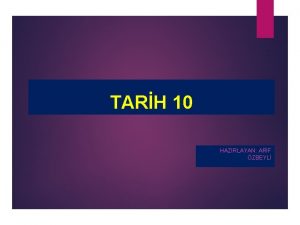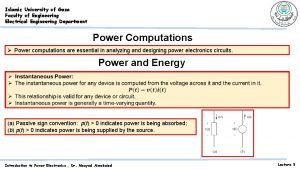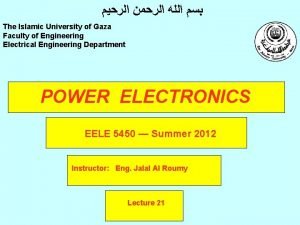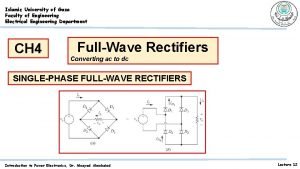The Islamic University of Gaza Faculty of Engineering

















- Slides: 17

ﺑﺴﻢ ﺍﻟﻠﻪ ﺍﻟﺮﺣﻤﻦ ﺍﻟﺮﺣﻴﻢ The Islamic University of Gaza Faculty of Engineering Electrical Engineering Department POWER ELECTRONICS EELE 5450 — Summer 2012 Instructor: Eng. Jalal Al Roumy Lecture 7

Chapter Three The five layers, n 1, p 1, n 2, p 2, n 3 can. Diacs be combined into a single Triacs and structure to form a new device. A power with four respect layers conducts one direction When T 1 device is positive to T 2 byinvoltage greater only. than Bidirectional device may be obtained byon. connecting two of VBO (p 2, n 2, p 1, n 1) thyristor will be these back-to-back. If Reverse polarity (p 1, n 2, p 2, n 3) will be on.

Chapter Three A five-layer diac is a device used without to trigger agate can other be designed semiconductor for various power breakdown switches. Current voltagesand andvoltage currentratings. are A diac determined is a five-layer by the gateless type of device.

Chapter Three A five-layer device with gate is called triac. ( four stages)

Chapter Three Unijunction Transistor (UJT) Complementary unijunction transistor (CUJT) Programmable unijunction transistor (PUT) The UJT has one pn junction and is used mainly as a triggering device in thyristor circuits and can also be used in oscillator circuits. The symbol is similar to a JFET. Note the angle of the emitter. The other terminals are called base 1 and base 2. The characteristics are quite different than any other transistor.

Chapter Three The resistive equivalent circuit of a UJT shown makes it easier to understand its operation. The emitter current controls the value of r. B 1 inversely. The total resistance or interbase resistance (r. BB) equals the sum of r. B 1 and r. B 2. The standoff ratio ( ) is the ratio r. B 1/ r. BB.

Chapter Three UJT Operation: Unijunction transistor can trigger larger thyristors with a pulse at base B 1. With the emitter disconnected, the total resistance RBB, a datasheet item, is the sum of RB 1 and RB 2. RBBO ranges from 412 kΩ for different device types. The intrinsic standoff ratio η is the ratio of RB 1 to RBBO. It varies from 0. 4 to 0. 8 for different devices.

Chapter Three As VE increases, current IE increases up IP at the peak point. Beyond the peak point, current increases as voltage decreases in the negative resistance region. The voltage reaches a minimum at the valley point. The resistance of RB 1, the saturation resistance is lowest at the valley point.

Chapter Three IP and IV, are datasheet parameters; For a 2 n 2647, IP and IV are 2µA and 4 m. A, respectively. VP is the voltage drop across RB 1 plus a 0. 7 V diode drop; VV is estimated to be approximately 10% of VBB. Peak votage of UJT Vp Vp=ηVbb +Vd

Chapter Three Complementary unijunction Transistor (CUJT) Like standard UJT except that the currents and voltages applied to it are of opposite polarity. Ideal for stable oscillators, timers, frequency dividers.

Chapter Three Programmable unijunction Transistor (CUJT) Although it has the same name as a UJT the programmable unijunction transistor’s structure is not the same. It is actually more similar to an SCR.

Chapter Three Programmable unijunction Transistor (CUJT) The PUT can be “programmed” to turn on at a certain voltage by an external voltage divider. This yields a curve similar to a UJT.

Chapter Three Programmable unijunction Transistor (PUT) External PUT resistors R 1 and R 2 replace unijunction transistor internal resistors RB 1 and RB 2, respectively. These resistors allow the calculation of the intrinsic standoff ratio η.

Chapter Three Programmable unijunction Transistor (PUT) VR is voltage divider (R 1 and R 2 can be specified) Vc capacitor voltage When Vc > VR the PUT will conduct

Chapter Three Programmable unijunction Transistor (PUT)

Chapter Three unijunction Transistor trigger circuits

Chapter Three LASCR (Light Activated SCR) End of Lecture
 Feup university of porto
Feup university of porto Lebanese university roumieh
Lebanese university roumieh Ece clemson
Ece clemson Faculty of mechanical engineering thammasat university
Faculty of mechanical engineering thammasat university Bil soruyu bas gaza
Bil soruyu bas gaza Pakimires
Pakimires Bil soruyu bas gaza
Bil soruyu bas gaza Gaza strip map
Gaza strip map Gaza strip map
Gaza strip map Mapa franja de gaza
Mapa franja de gaza Mapa palestina
Mapa palestina Gaza central desalination plant
Gaza central desalination plant Gáza
Gáza Oshbe
Oshbe Islamic university college
Islamic university college Lee kong chian faculty of engineering and science
Lee kong chian faculty of engineering and science Czech technical university in prague civil engineering
Czech technical university in prague civil engineering Benha faculty of engineering
Benha faculty of engineering

































